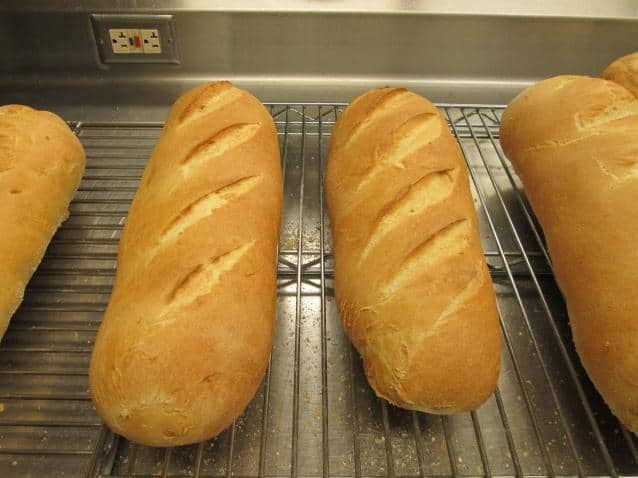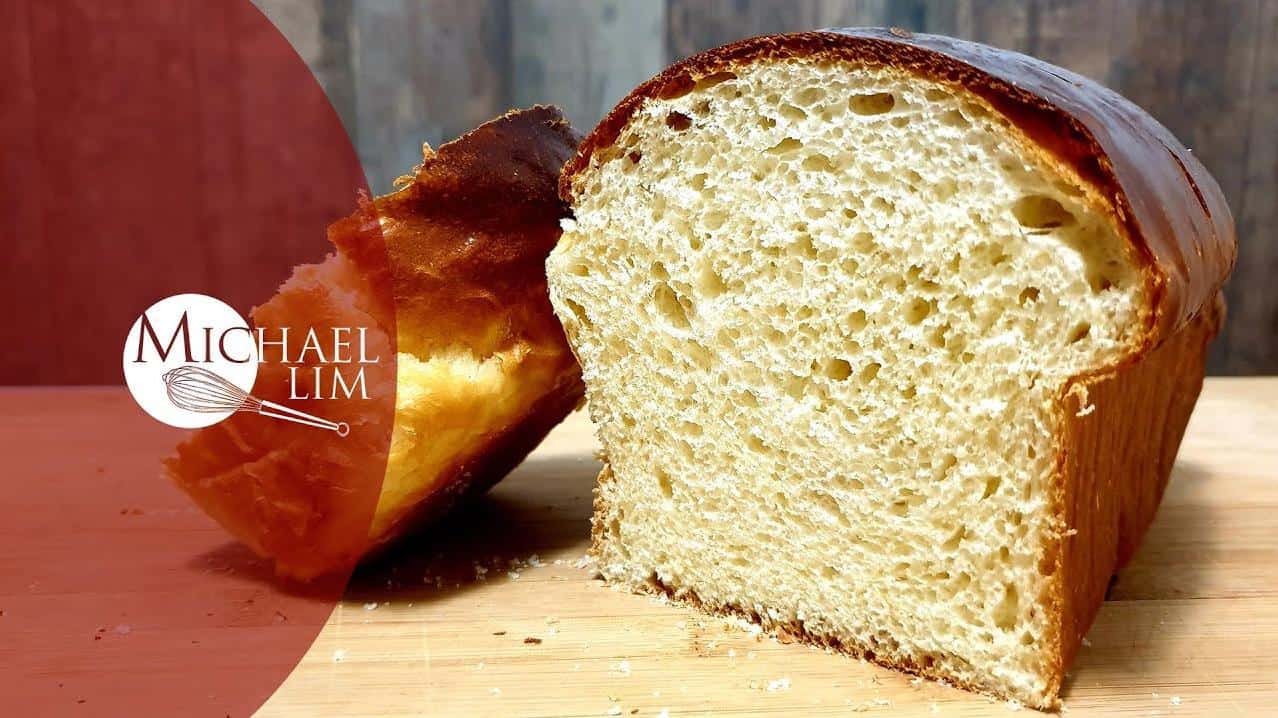French Bread, Sponge Method Dough Recipe
Welcome to my French Bread recipe using the Sponge Method Dough! I always say, there’s nothing quite like the smell of freshly baked bread in your home. This recipe will teach you how to make the perfect crusty French bread that will have your family and friends impressed.
Bread-making is a science, and there are many ways to achieve the desired result. However, I have found that the sponge method is one of the best techniques to use when making French bread. The sponge is a pre-ferment that allows the yeast to develop and create a more flavorful dough. It also helps to create the perfect texture and crust.
In this recipe, I will guide you through the step-by-step process of creating a delicious French bread using the sponge method. With just a few ingredients and some patience, you’ll have a crusty and flavorful loaf of bread that everyone will love.
So, let’s get started on this delicious French Bread recipe using the Sponge Method Dough!
Why You’ll Love This Recipe

If you are a bread lover, then you are going to absolutely adore this French Bread made with the sponge method dough recipe. This recipe is perfect for those who are looking for a crusty, golden brown bread that is perfect for any occasion. Here’s why you’ll love this recipe:
Firstly, the sponge method dough recipe is an incredibly easy and efficient way to make bread. The sponge is made by mixing yeast, flour, and water together and allowing it to ferment for a specified period of time. This allowed ferment period of time allows the dough to become more flavorful and develop a unique texture that is perfect for French bread.
Secondly, this recipe produces a crusty French bread that is perfect for any meal. The bread is soft and airy on the inside with a crispy crust that is perfect for dipping into soups or sauces. The crusty exterior of the bread is a result of the unique mixing method used in this recipe, which allows the dough to develop a crispy exterior while remaining soft and fluffy on the inside.
Thirdly, this recipe is incredibly versatile and can be adapted to suit your individual tastes. You can add different ingredients to the dough to create different variations of French bread such as whole wheat, sourdough, or even Italian bread. You can also shape the dough into different shapes such as baguettes or rolls, making it perfect for any occasion.
Finally, this recipe is perfect for those who are looking to make homemade bread but don’t have access to a bread machine. With just a few simple ingredients and a little bit of time, you can make delicious homemade French bread in no time. Plus, the satisfaction of making your own bread from scratch is unmatched!
In conclusion, if you’re looking for a simple and delicious French bread recipe, then look no further than this sponge method dough recipe. With its crispy crust and soft, airy interior, this bread is perfect for any occasion and is sure to please even the most discerning bread lover.
Ingredient List

Here are the ingredients you will need for this crusty French bread recipe using the sponge method dough:
Bread Sponge Ingredients:
- 1 tsp yeast
- 1 1/2 cups warm water
- 2 cups all-purpose flour
Dough Ingredients:
- 1 1/2 tsp salt
- 1/2 tsp yeast
- 1/2 cup water
- 3 1/2 cups all-purpose flour
Note that you can also use bread flour for a chewier texture or whole wheat flour for a healthier option. The amount of water may vary depending on the type of flour you use, so adjust accordingly. It’s also important to use warm water to activate the yeast properly.
The Recipe How-To
Now that you have gathered all the ingredients, it’s time to start making the French bread using the Sponge Method Dough Recipe. In this recipe, we’re going to use the sponge method, which involves making a pre-ferment that allows the dough to develop a more complex flavor and softer texture. Here is how you can make it:
Step 1: Make the Sponge
- In a large mixing bowl, mix together 1 cup of flour, 1 teaspoon of salt, and 1/4 teaspoon of yeast.
- Add 1 1/2 cups of water and mix until well combined.
- Cover the bowl with plastic wrap and let it sit at room temperature for 12-14 hours. This period will allow the sponge to ferment and develop flavor.
Step 2: Make the Dough
- In a separate mixing bowl, combine 2 cups of flour and 1 teaspoon of salt.
- Pour the sponge mixture into the bowl and mix until well combined.
- Knead the dough for about 10 minutes until it becomes smooth and elastic.
- Place the dough in a lightly greased bowl and cover it with a clean dishcloth. Let the dough rise at room temperature for 1-2 hours.
Step 3: Shape the Dough
- After the dough has risen, punch it down to remove any excess air.
- Transfer the dough to a floured work surface and shape it into a long loaf.
- Place the loaf on a greased baking sheet or a baguette pan and let it rise for another 30-40 minutes.
Step 4: Bake the Bread
- Preheat your oven to 450°F (230°C).
- Lightly score the top of the bread with a sharp knife or razor blade.
- Bake the bread for 20-25 minutes or until it becomes golden brown and crusty.
- Remove the bread from the oven and let it cool completely on a wire rack before slicing and serving.
With this recipe, you can enjoy the delicious taste of homemade French bread, made using the sponge method mixing. Remember to follow the steps carefully, from making the sponge to baking the bread, to get the best results.
Substitutions and Variations

One of the beauties of bread-making is that there’s always room to experiment with different ingredients and methods. Here are some substitutions and variations you can try with this French bread sponge method dough recipe:
– Flour: While this recipe calls for all-purpose flour, you can also use bread flour for a chewier texture, or whole wheat flour for a nuttier flavor. Keep in mind that different flours absorb water differently, so you may need to adjust the amount of water accordingly.
– Yeast: If you don’t have instant yeast, you can use active dry yeast instead. Just make sure to activate it in warm water first, and adjust the amount accordingly (use 25% more active dry yeast than instant yeast). You can also experiment with different types of yeast, such as sourdough starter or wild yeast.
– Autolyse: Some bakers like to add an autolyse step to their bread-making process, which involves mixing the flour and water before adding the yeast and salt. This allows the flour to hydrate fully and develop gluten before the other ingredients are added. If you want to try this, simply mix the flour and water together and let them sit for 30 minutes before adding the other ingredients.
– Baking: While this recipe calls for baking the bread on a baguette pan, you can also bake it on a regular baking sheet or in a Dutch oven (for a more rustic, crusty bread). You can also experiment with different baking temperatures and times to achieve different crusts and textures.
– Flavorings: If you want to add some extra flavor to your French bread, try adding herbs (such as rosemary or thyme) or spices (such as garlic or onion powder) to the dough. You can also experiment with different types of flour (such as rye or spelt) for a unique flavor profile.
– Shape: While baguettes are the traditional shape for French bread, you can also experiment with other shapes (such as round loaves or rolls) to suit your preferences. Just make sure to adjust the baking time accordingly.
Overall, don’t be afraid to experiment and try new things with this French bread sponge method dough recipe. With a little creativity and ingenuity, you can create a bread that’s uniquely yours.
Serving and Pairing

Once your crusty French bread is baked and has cooled down, it’s time to serve it up! There are so many ways to enjoy freshly baked bread, whether it’s for breakfast, lunch, dinner, or a snack.
For breakfast, I love to slice the French bread and toast it, then serve it with butter and jam or honey. You can also use it as the base for French toast or bread pudding. For lunch, you can make a sandwich with your favorite ingredients, such as sliced deli meat, cheese, lettuce, and tomato. The crusty texture of the bread adds a nice contrast to the soft, savory fillings.
At dinner time, you can use the bread to soak up flavorful sauces or soups, or serve it alongside a salad or pasta dish. It’s also perfect for making bruschetta or garlic bread to serve as an appetizer.
When it comes to pairing, crusty French bread goes well with a variety of foods and beverages. For a classic French pairing, serve it with a cheese plate and a glass of red wine. It also complements Italian cuisine, such as pasta dishes, pizza, or antipasto plates. For a lighter pairing, you can serve it with a salad or soup and a glass of white wine or sparkling water.
Overall, the possibilities are endless when it comes to serving and pairing crusty French bread. Get creative and experiment with different flavors and combinations to find your perfect match.
Make-Ahead, Storing and Reheating

Making French bread using the sponge method dough recipe requires a bit of time and patience, but the good news is that you can make it ahead of time and store it for later use. In fact, making the dough a day before and refrigerating it overnight can actually improve the flavor and texture of the bread.
To make the dough ahead of time, simply follow the recipe instructions until after the first rise. Punch down the dough and shape it into a ball, then place it in a large, lightly oiled bowl and cover it tightly with plastic wrap. Refrigerate the dough for up to 24 hours. When you’re ready to bake, remove the dough from the refrigerator and let it come to room temperature before shaping it into loaves and baking.
Storing French bread is easy, but it’s important to do it properly to keep the bread fresh and crusty. Once cooled, wrap the bread tightly in plastic wrap or aluminum foil and store it at room temperature for up to three days. If you want to keep it for longer, you can freeze the bread for up to three months. To reheat, simply wrap the frozen bread in foil and bake it in a preheated 350°F oven for 10-15 minutes.
When it comes to serving the bread, there are endless possibilities. French bread is perfect for making sandwiches, toasting for breakfast, or serving alongside a hearty soup or stew. It also pairs well with cheese and wine. For a more rustic look, you can serve the bread on a wooden board with some olive oil and balsamic vinegar for dipping.
In summary, you can easily make French bread using the sponge method dough recipe ahead of time and store it for later use. Properly storing and reheating the bread will ensure that it stays fresh and crusty. With its versatility, French bread is a great addition to any meal or occasion.
Tips for Perfect Results

To achieve perfect results with this French bread sponge method dough recipe, here are some tips that will come in handy.
1. Use high-quality ingredients
The quality of the ingredients used in bread making can make a huge difference in the final result. Always use fresh, high-quality flour, yeast, and water to ensure the best possible outcome.
2. Weigh ingredients accurately
To ensure consistency and accuracy, it’s important to weigh all of the ingredients accurately using a digital scale. This is especially important when making sourdough bread or when using whole wheat flour.
3. Mix the sponge ingredients properly
When mixing the sponge ingredients, it’s important to mix them thoroughly until they are well-combined. This will ensure that the yeast is evenly distributed throughout the sponge.
4. Allow the sponge to ferment properly
The sponge needs to be allowed to ferment properly for the bread to rise and develop a good flavor. Follow the recipe instructions carefully, and don’t rush the fermenting process.
5. Use the autolyse method
The autolyse method involves mixing the flour and water together and allowing them to rest for a period of time before adding the yeast and salt. This method helps to develop gluten and improve the texture of the bread.
6. Knead the dough properly
Kneading the dough helps to develop gluten and improve the texture of the bread. Use a stand mixer or knead the dough by hand for at least 10 minutes until it’s smooth and elastic.
7. Use a baguette pan
A baguette pan is the best tool for making French bread. It allows the bread to rise properly and develop a nice crust. If you don’t have a baguette pan, you can use a baking sheet, but the bread may not turn out as well.
8. Bake the bread at the right temperature
Baking the bread at the right temperature is crucial for achieving a crispy crust and a soft, fluffy interior. Follow the recipe instructions carefully and preheat your oven to the correct temperature before baking.
By following these tips, you’ll be able to make delicious, crusty French bread using the sponge method dough recipe. Don’t be afraid to experiment with different variations and substitutions to create your own unique bread recipes!
FAQ
Now, let’s address some frequently asked questions about this French bread sponge method dough recipe. Whether you’re a novice or an experienced baker, you may have a few concerns or queries about the recipe or the bread-making process. Don’t worry, I’ve got you covered. In this section, I’ll try to answer some of the most common questions that you might have. So, let’s dive right in!
How do you make a sponge dough method?
To make bread using the sponge and dough method, the process involves two stages. Firstly, a sponge is created and left to ferment for a period of time, and secondly, the fermented sponge is added to the final dough ingredients to create the total formula.
Is straight dough method the same as sponge method?
There are different methods that bakers use to mix ingredients in bread making. The straight-dough method involves mixing all the ingredients at once. On the other hand, the sponge-dough method only mixes some of the ingredients to form a sponge that ferments before adding the remaining ingredients. Another method, the sponge-and-dough mixing method, has two stages where the ingredients are mixed.
What kind of bread is the sponge method good for?
If you’re looking to create bread with a more complex flavor and lighter texture, the sponge mixing method is a great technique to try. This process works especially well for whole grain breads, but keep in mind that it does require a longer baking process overall.
What ingredient makes bread spongy?
When flour is combined with yeast, it creates a chemical reaction. The yeast consumes the sugars in the flour and releases gases that create air pockets within the dough. Kneading the dough helps to form a mesh-like structure with the gluten that traps these gases, resulting in a light and airy bread.
Bottom Line
In conclusion, the French Bread Sponge Method Dough Recipe is a fantastic addition to your baking repertoire. It is easy to make, requires only a few ingredients, and produces a crusty and flavorful bread that will impress your family and friends. By following the simple steps outlined in this recipe, you can create homemade French baguettes that are just as good as those from a bakery.
The sponge method is an excellent mixing method that allows the dough to ferment and develop flavor before adding the remaining ingredients. This process results in a more complex and nuanced taste, making the bread much more enjoyable to eat. Additionally, the sponge method dough recipe is versatile and can be customized to suit your preferences, whether you prefer a whole wheat or sourdough bread.
In summary, the French Bread Sponge Method Dough Recipe is a must-try for all bread-making enthusiasts. With its simple steps, easy-to-follow instructions, and delicious results, you will be hooked on this recipe in no time. So, what are you waiting for? Grab your ingredients and start baking today!
French Bread, Sponge Method Dough Recipe

This method is pretty easy and makes a great flavored French Bread. I have used it a lot over the years and have lost the recipe couple of times (forcing a major recipe cleanup)… it’s one I definitely don’t want to lose. I learned it at a bread making class. I often double the recipe. The 12 hours "cooking time" is really the time the sponge must sit to develop flavor, plus rising time.
Sponge
- 1 teaspoon yeast or 1/4-1/2 cup sourdough starter
- 1 cup water
- 1 cup flour
Finish
- 1 teaspoon salt (don’t add yet, but be sure not to forget it!)
- flour, enough to make a workable dough
- Mix yeast or sourdough starter with water and 1 cup flour.
- Cover and let rise overnight.
- Add salt and enough flour to make a workable dough (I usually use 30-40% whole wheat flour for a more nutritious final product).
- Knead, shape, and let rise until almost double.
- Bake in a 450 degree F oven for ~20 minutes.
- To acheive a better crust, preheat a shallow pan on bottom rack, and pour in 2 cups of water when you begin baking bread. This is one of the secrets to the desired crust on a French or Artisan bread.
- Enjoy!
[custom-related-posts title=”Recommended Recipes Just For You” none_text=”None found” order_by=”date” order=”ASC”]
